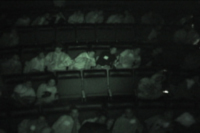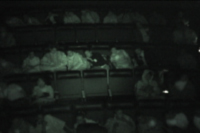| |
Lessons Learned:
Cretaceous Chaos attempted to seamlessly interweave interactive
segments with an educational narrative. User testing revealed some
good rules of thumb in dealing with interactive pieces for a large
audience.
|
|
- Continuous,
synchronous interaction is more effective than branching,
asynchronous interaction. Audiences felt like they had control
in the canyon sequence, where they dynamically navigated
left and right through a river. The beginning and the end
of the piece employed interactions (voice and audience activity
level, respectively) that led to branches in the narrative.
In order for the audience to fully understand that they
had options, they would need to see the show several times.
- The
rules of the game need to be established imediately. The
first thing that happens in Cretaceous Chaos is that the
audience is asked "if they're ready to go see some
dinosaurs" and the experience responds according to
the volume of their vocal response. This immediately makes
it clear to guests that they're participation is expected.
- The
rules of the game need to be abided by. Cretaceous Chaos
starts with an audio interaction, but the computer can only
hear and respond to the audience at select times. There
needed to be a clearer distinction as to when the audience
could actually interact.
- Choices
must be very clearly delineated. The initial canyon models
did not provide enough lead time for audiences to see that
they could steer down different paths. This issue was resolved
in a later iteration.
- Employ
social conventions...they work and they're free! During
the launch sequence, ANDI invites the audience to count
down with her. Without fail, every audience joined in with
"5! 4! 3! 2! 1!"
|
Empirical
Results:
Due to production-related constraints, the team was only able to
collect limited data about the effectiveness of Cretaceous Chaos
as an educational interactive piece. Quizzes administered to select
audiences before and after viewing indicated that 10, 11, and 12
year olds learned, by watching the show, the key information that
the team hoped to convey -- namely, the difference between reptiles
and dinosaurs and theorized dinosaur eating habits. More data is
required to draw any concrete conclusions.
Challenges
and the Future:
This was an ambitious project of considerable scope. Unfortunately,
the technical infrastructure is not yet robust enough to reliably
handle the load of a 15 minute show completely rendered in real
time. Numerous production elements had to be scaled back substantially
in order to get a decent frame rate even a fraction of the time.
The ETC's Panoramic
Real-time Interaction System currently renders with a single PC.
For the future, the system will inevitably have to evolve to employ
multiple networed PC's if it is to handle production-level content.
Cretaceous Chaos
will be submitted for consideration to the Carnegie Museum of Natural
History's education and marketing departments. If nothing else,
it will routinely run as an extra event for summer camp and overnight
groups at the museum.
|
|


